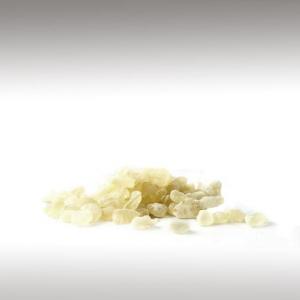
MASTIC ESSENTIAL OIL (PISTACIA LENTISCUS) - ESSENTIAL OILS

BASE / GENERAL DATA
Information submited: December 14, 2015 Modified: March 15, 2018 By: OperaDreamhouse
Botanical Name: Pistacia lentiscus
Common Method of Extraction: Steam distillation
Part Typically Used: Resin - gum
Color: Dark green
Consistency: Thick
Perfumery Note: Middle / Base
Strength of Initial Aroma: Light, slightly balsamic, fresh, lemony, gentle fragrance.
Blends Well With: Frankincense, Myrrh, Rose Otto, Cardamom, Clove, Grapefruit, Lemon, Grand Fir, Rockrose, Immortelle, Inula and Palo Santo.
It is collect leaves and young twigs from Pistacia Lentiscus in the spring, when the plants flower. The plant - material has to be distilled fresh, so collection and distillation takes place the same day. A 4 hour distillation yields about 0.2% of essential oil. The oil has a lemony, balsamic, resinous scent.
As the resin, also the leaves, twigs, flowers and berries contain a small amount of essential oil, which can be distilled. The essential oil obtained from the gum / resin is commonly called Mastic oil, whereas the oil obtained from the leaves is correctly called lentisk oil.
Pistacia Lentiscus has been known for thousands of years. It is another herb known to the ancient Egyptians, who used its resin as an incense and for embalming. Recently scientists found evidence of mastic gum trade from Chios 2400 years ago, when they analysed remains in amphorae from a shipwreck off the island.
The bush is attributes to Artemis (Diana). Dictynna, an ancient virgin-huntress was a priestess of Artemis, and a goddess in her own right in Crete, where she was worshiped since Minoan times.
It is told, that king Minos chased the nymph Britomaris, who leapt into the sea off a steep cliff to avoid his pursuits. She was deified and rewarded with immortality for her chastity by Artemis, who gave her the name Dictynna, lady of the nets, and turned her priestess into a Lentisk bush so that she forever could remain a virgin. Its balsamic, resinous scent symbolizes virginity and purity, the eternal maiden aspect of Artemis.
Common Method of Extraction: Steam distillation
Part Typically Used: Resin - gum
Color: Dark green
Consistency: Thick
Perfumery Note: Middle / Base
Strength of Initial Aroma: Light, slightly balsamic, fresh, lemony, gentle fragrance.
Blends Well With: Frankincense, Myrrh, Rose Otto, Cardamom, Clove, Grapefruit, Lemon, Grand Fir, Rockrose, Immortelle, Inula and Palo Santo.
It is collect leaves and young twigs from Pistacia Lentiscus in the spring, when the plants flower. The plant - material has to be distilled fresh, so collection and distillation takes place the same day. A 4 hour distillation yields about 0.2% of essential oil. The oil has a lemony, balsamic, resinous scent.
As the resin, also the leaves, twigs, flowers and berries contain a small amount of essential oil, which can be distilled. The essential oil obtained from the gum / resin is commonly called Mastic oil, whereas the oil obtained from the leaves is correctly called lentisk oil.
Pistacia Lentiscus has been known for thousands of years. It is another herb known to the ancient Egyptians, who used its resin as an incense and for embalming. Recently scientists found evidence of mastic gum trade from Chios 2400 years ago, when they analysed remains in amphorae from a shipwreck off the island.
The bush is attributes to Artemis (Diana). Dictynna, an ancient virgin-huntress was a priestess of Artemis, and a goddess in her own right in Crete, where she was worshiped since Minoan times.
It is told, that king Minos chased the nymph Britomaris, who leapt into the sea off a steep cliff to avoid his pursuits. She was deified and rewarded with immortality for her chastity by Artemis, who gave her the name Dictynna, lady of the nets, and turned her priestess into a Lentisk bush so that she forever could remain a virgin. Its balsamic, resinous scent symbolizes virginity and purity, the eternal maiden aspect of Artemis.

SPIRITUAL PRACTISES DATA
Information submited: December 14, 2015 Modified: March 15, 2018 By: OperaDreamhouse
Element Association: Air
Magical Associations: Awareness
Astrological Association: Gemini, Aquarius
Planetary Association: Sun
Season: Spring
Emotional Attributes: clarifying and mentally refreshing, cleansing / purifying, meditation, prayer, love.
Magical Associations: Awareness
Astrological Association: Gemini, Aquarius
Planetary Association: Sun
Season: Spring
Emotional Attributes: clarifying and mentally refreshing, cleansing / purifying, meditation, prayer, love.

MEDICINE / HEALTH DATA
Information submited: December 14, 2015 Modified: February 21, 2018 By: OperaDreamhouse
Pregnancy / Lactation: Information regarding safety and efficacy in pregnancy and lactation is lacking.
Contraindications: Avoid use with hypersensitivity to any ingredients of mastic gum as well as with pollen hypersensitivity.
It is an energetically complex essential oil. It has a similar property to Peppermint in its ability to clear away old, stagnant energies. In fact, this is what Mastic seems to do best, clearing on the physical as well as energetic levels.
Contraindications: Avoid use with hypersensitivity to any ingredients of mastic gum as well as with pollen hypersensitivity.
It is an energetically complex essential oil. It has a similar property to Peppermint in its ability to clear away old, stagnant energies. In fact, this is what Mastic seems to do best, clearing on the physical as well as energetic levels.

BEAUTY / COSMETICS DATA

FOOD / COOKING DATA
Information submited: December 14, 2015 Modified: March 15, 2018 By: OperaDreamhouse
Besides being used in toothpaste, chewing gum and confectionery, mastic is an ingredient in the making of liqueurs. A Greek grape spirit, Mastiha, is flavoured with the resin, as is the Turkish liqueur, raki.
It is essential in rahat locum, the authentic Turkish delight, and it is found in recipes for breads and pastries, ice creams, sweet puddings and almond cake. Mastic is also used as a binding agent with oil, lemon juice and spices to coat the traditional Turkish doner kebab - as the meat cooks, thin slivers are sliced off and served in pita bread.
Originally a sap, Mastic is sun - dried into pieces of brittle,translucent resin. When chewed, the resin softens and becomes a bright white and opaque gum. The flavor is bitter at first, but after some chewing, it releases a refreshing, slightly pine or cedar - like flavor.
Mastic was the original chewing gum and mouth freshener. As a hardened gum, the flavour is initially bitter, but after a few minutes of chewing takes on its gummy consistency and releases a mouth freshening flavour which remains for about 15 to 20 minutes.
n Greece the best mastic comes from the island of Chios. It is used in the baking of bread and pastries, and also for one of the traditional "Spoon Sweets", gliko tou koutaliou. A spoonful of this gooey sweet followed by a glass of ice - cold water is marvellous in hot weather. In Cyprus, small rings of Mastic - flavoured bread are topped with Sesame seeds.
Mastic pounded with sugar and Rose or Orange Blossom water is a popular flavouring in the Middle East, used in desserts, sweetmeats, ice cream, syrups and cordials. Only small amounts are necessary, a quarter to half teaspoon sufficing for a dish for four people.
Resin is chewed as a chewing gum and used to flavor cakes, desserts, and candy. The oil is used in the liqueur mastiche and the Greek candy masticha.
COMMENTS
No comments.


